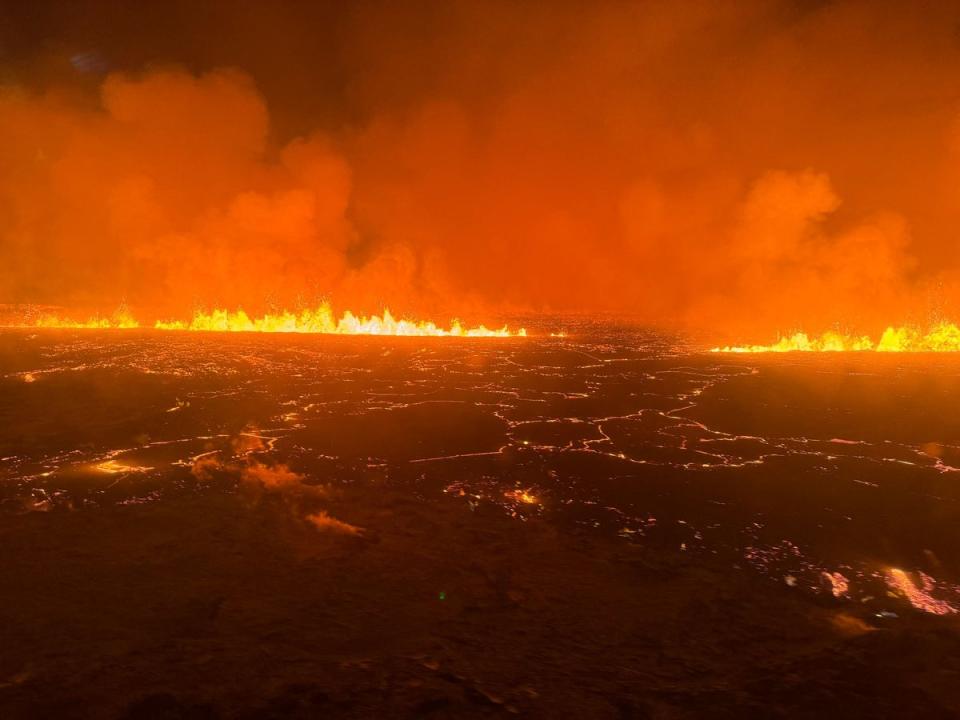Iceland volcano gas pollution could reach capital Reykjavik in hours, experts warn

Gas pollution from a large volcanic eruption in Iceland could reach the capital Reykjavik in the coming hours, officials have said.
Experts at the Icelandic Met Office believe the city is at risk of exposure on Tuesday night or Wednesday.
They said: "According to the weather forecast, gas pollution could be noticed in the capital area late tonight or in the morning.
"New work is being done on a hazard assessment card and it will be issued later."
The eruption late on Monday on the Reykjanes peninsula in southwest Iceland spewed lava and smoke more than 100 metres (330 feet) into the air after weeks of intense seismic activity.

"The eruption does not present a threat to life," an Icelandic government statement said.
"There are no disruptions to flights to and from Iceland and international flight corridors remain open."
Authorities last month evacuated the nearly 4,000 inhabitants of the fishing town of Grindavik about 40 km (25 miles) southwest of capital city Reykjavik.
Images and live streaming of the eruption shown by Reuters and others showed bright yellow, orange and red lava in sharp contrast against the night sky.
The eruption opened a 4 km (2.5 mile) fissure from which lava fountains emerged. But at its southernmost point the crack was still 3 km away from Grindavik, Iceland's Meteorological Office said.
"The eruption is taking place north of the watershed, so lava does not flow towards Grindavik," geologist Bjorn Oddson told public broadcaster RUV.
Located between the Eurasian and the North American tectonic plates, among the largest on the planet, Iceland is a seismic and volcanic hot spot because the two plates move in opposite directions
Grainy webcam video showed the moment of the eruption as a flash of light illuminating the sky at 10.17pm local time.
As the eruption spread, magma, or semi-molten rock, could be seen spewing along the ridge of a hill.

Vidir Reynisson, head of Iceland’s civil protection and emergency management, told the Icelandic public broadcaster RUV: “The magma flow seems to be at least a hundred cubic meters per second, maybe more.
“So this would be considered a big eruption in this area at least.”
In November, police evacuated the town of Grindavik after strong seismic activity in the area damaged homes and raised fears of an imminent eruption. The nearby Blue Lagoon geothermal spa was also closed.
The eruption could be seen from Reykjavik, about 26 miles north-east of Grindavik.

Iceland sits above a volcanic hot spot in the North Atlantic and averages an eruption every four to five years.
The most disruptive in recent times was the 2010 eruption of the Eyjafjallajokull volcano, which spewed huge clouds of ash into the atmosphere and grounded flights across Europe for days because of fears ash could damage airplane engines.
Scientists say a new eruption would likely produce lava but not an ash cloud.
Iceland’s foreign minister, Bjarne Benediktsson said on X, formerly known as Twitter, that there are “no disruptions to flights to and from Iceland and international flight corridors remain open”.

A coast guard helicopter will attempt to confirm the exact location - and size - of the eruption.
Grindavik, a fishing town of 3,400, sits on the Reykjanes Peninsula, about 31 miles southwest of the capital, Reykjavik and not far from Keflavik Airport, Iceland’s main facility for international flights.

 Yahoo News
Yahoo News 
